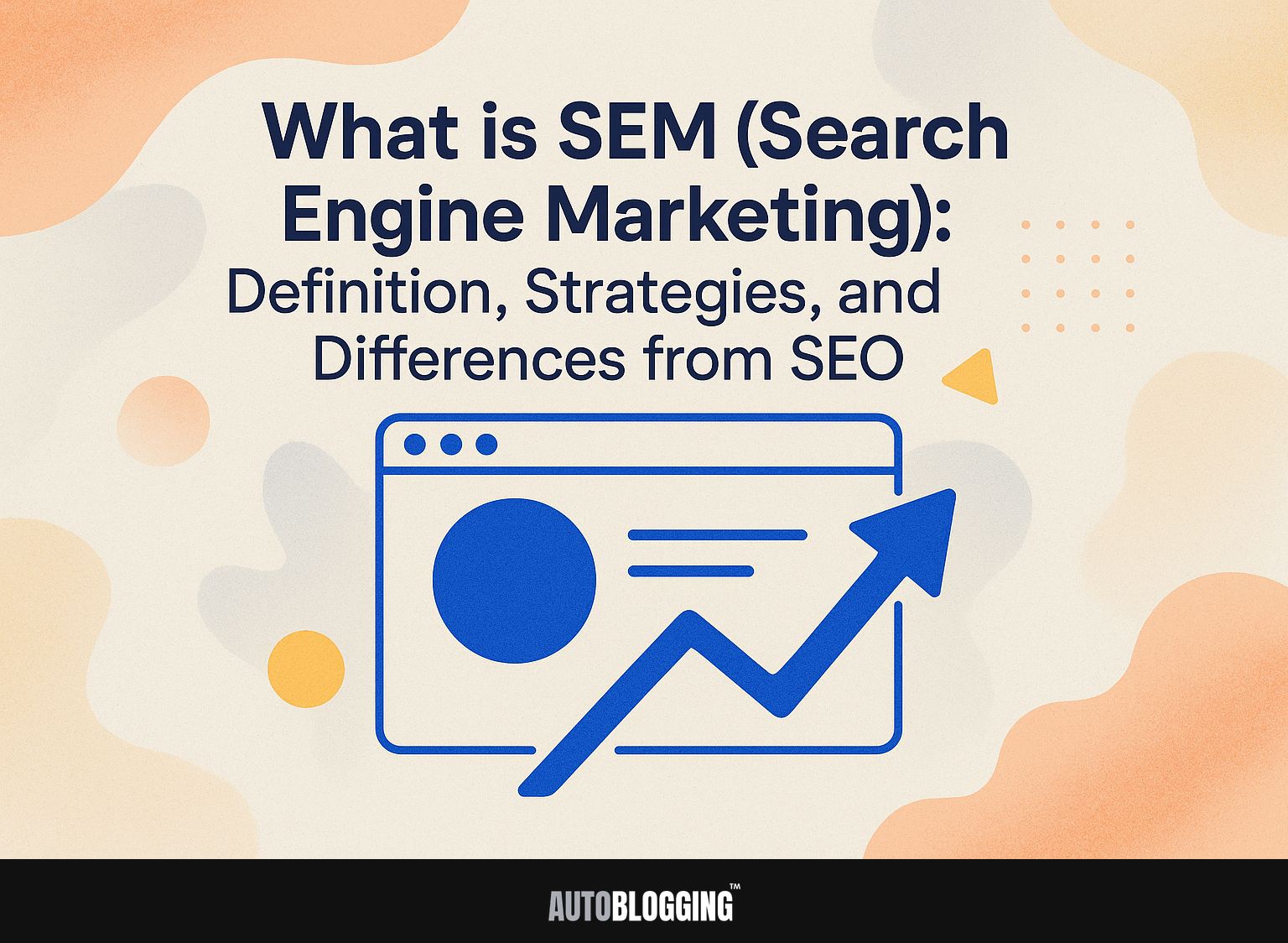
Knowing SEM (Search Engine Marketing) is essential for increasing your online presence in the changing online world. SEM includes different methods to improve how often people find you on search engines, and it is different from standard SEO. This article explains what SEM is, its main strategies, and how it is different from SEO, giving you important information to improve your online marketing.
Key Takeaways:
- SEM is a digital marketing strategy that involves paid search advertising, SEO, and PPC. It is important for increasing website visitors and making the site more noticeable online.
- Effective SEM strategies include keyword research, ad optimization, bid management, landing page optimization, and performance tracking. These techniques help improve ad relevance and drive conversions.
- While SEM and SEO are both important for online marketing, they differ in terms of cost structure, time to results, targeting, and sustainability. Utilizing the right tools and avoiding common mistakes can lead to successful SEM campaigns.
Contents
1. Definition of SEM
SEM includes different methods to increase website visibility using paid ads and improving organic search outcomes. This approach includes pay-per-click (PPC) campaigns, where companies pay to show up in search results, and search engine optimization (SEO), which improves site visibility without paid ads.
For instance, Google Ads remains a leading tool for PPC, offering granular targeting options that can increase ROI by focusing on high-intent queries. In contrast, effective SEO requires quality content, keyword research, and backlink strategies, with over 60% of clicks going to the top three organic search results.
As of 2023, SEM continues to grow rapidly, constituting over 46% of total digital marketing budgets.
2. Importance of SEM in Digital Marketing
SEM accounts for 45% of total online marketing budgets, underscoring its significance in driving traffic and conversions effectively. Investing in SEM can yield impressive results, with businesses often seeing a 200% ROI on ad spend.
For example, using platforms like Google Ads allows marketers to focus on particular groups of people and perform A/B testing to improve ad results.
Using tools like SEMrush or Ahrefs helps pick better keywords, which makes ads more relevant and increases the likelihood of users clicking on them.
Regularly reviewing performance data keeps strategies effective. Changing bids and targeting based on these findings can greatly improve campaign results, leading to better use of marketing budgets.
Key Components of SEM
Knowing the main parts of SEM is important for businesses that want to use search engines well. For those interested in maximizing their SEM strategy, understanding the benefits and creation of effective ads is crucial. Our guide on PPC models can offer valuable insights into this aspect.
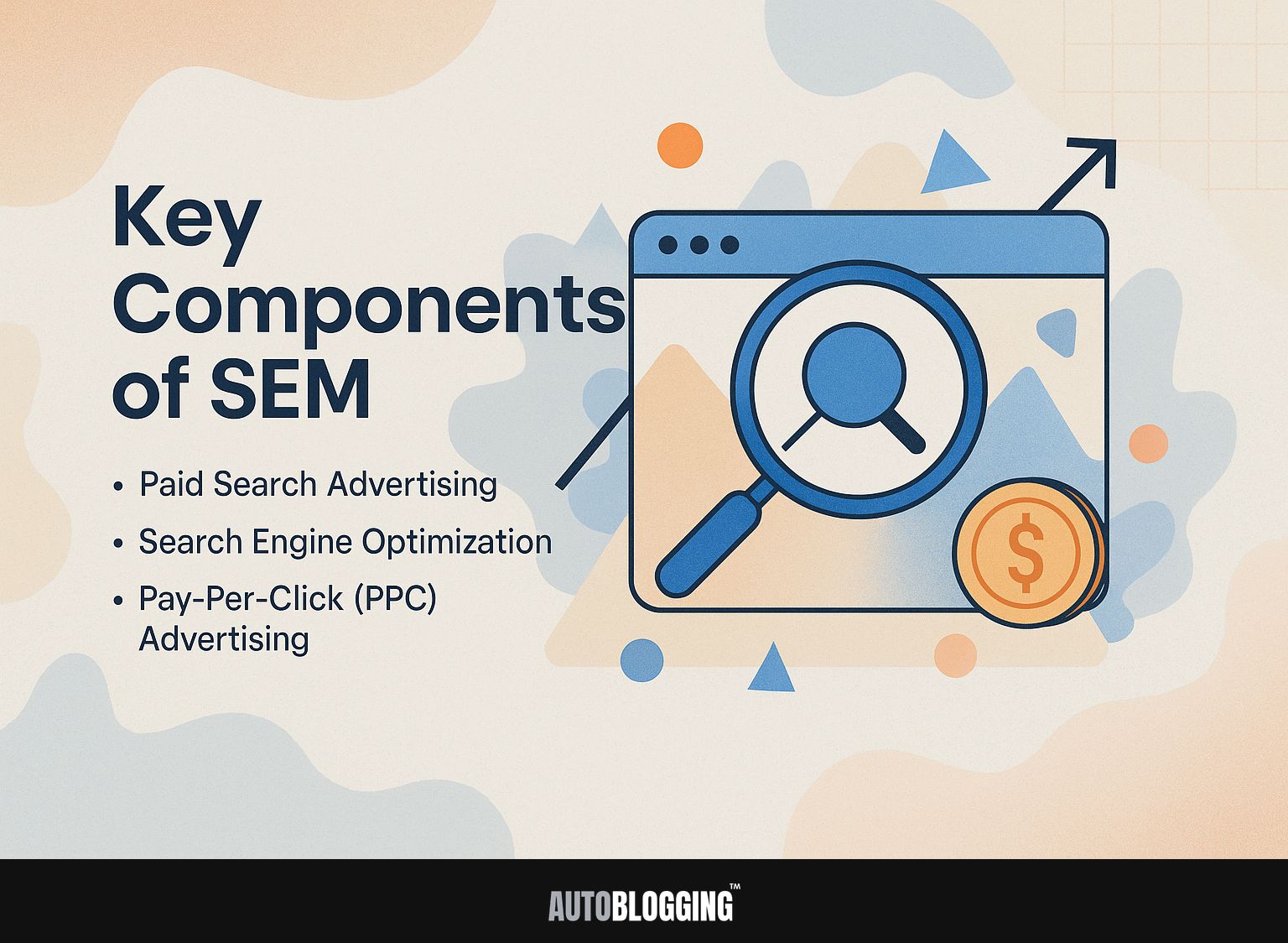
1. Paid Search Advertising
Paid search advertising, often executed through platforms like Google Ads, allows businesses to target specific keywords to reach potential customers instantly.
The process operates on an auction system where advertisers bid for keyword placements. When a user searches, Google evaluates bids and ad quality to determine which ads appear, often at the top of search results.
Focusing on the right keywords is important; average cost-per-click can differ greatly, often between $1 to $2 for popular keywords. Tools like Google Keyword Planner can help identify the best keywords, ensuring your advertising money is spent effectively.
Testing different versions of your ads will increase the number of clicks and sales.
2. Search Engine Optimization (SEO)
SEO involves improving website content to increase its position in search engine results and make it more noticeable.
On-page SEO involves strategies like keyword optimization, meta tags, and high-quality content creation. For example, using tools like Yoast SEO can check your content to make sure it’s full of keywords and still easy to read. To delve deeper into the methods and best practices, you can explore what SEO entails and how it can be effectively leveraged.
Off-page SEO, on the other hand, emphasizes building backlinks through methods such as guest blogging or participating in relevant forums. Having a solid set of backlinks can greatly increase your site’s credibility.
In the end, using both strategies together and regularly creating useful content is important for getting and keeping high search rankings.
3. Pay-Per-Click (PPC) Advertising
PPC advertising allows businesses to pay only when someone clicks on their ads, making it a cost-effective marketing strategy.
In PPC, businesses bid on keywords relevant to their target audience, determining how much they are willing to pay for each click. For example, using Google Ads, marketers can set different bids for various keywords based on their potential value.
You have many targeting choices; you can choose demographics, interests, and locations to make sure your ads are shown to the right audience.
To measure success, track metrics like Click-Through Rate (CTR) and conversion rates, using tools such as Google Analytics to analyze data and adjust tactics accordingly. This ongoing optimization can greatly improve ROI.
SEM Strategies
Using strong SEM methods is important for increasing your business’s visibility and attracting potential customers. For a deeper understanding of how these methods can complement your broader digital strategy, consider examining strategies for justifying your SEO investment.
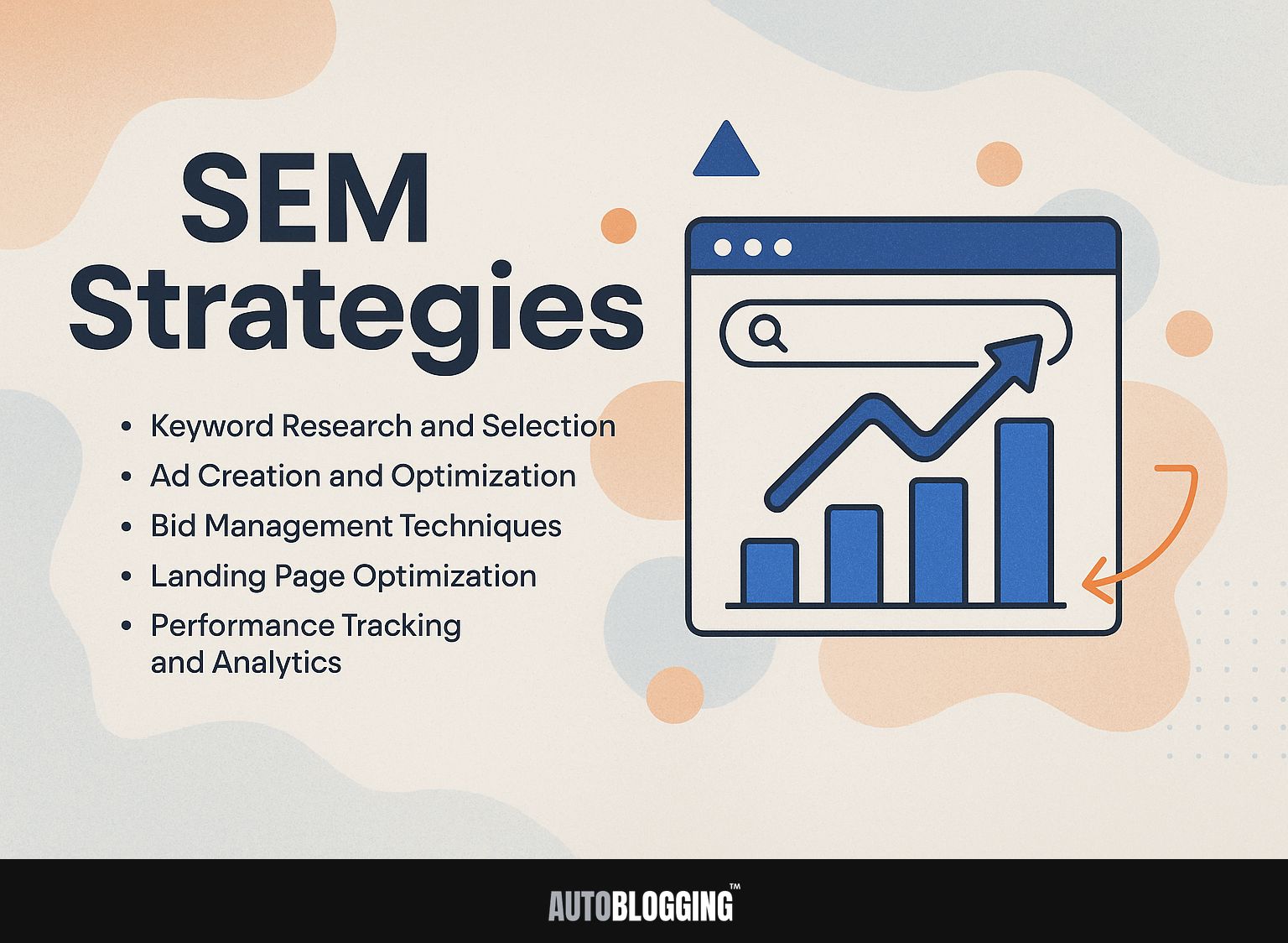
1. Keyword Research and Selection
Successful keyword research is essential for SEM. Tools like SEMrush and Google Keyword Planner give information on how often words are searched and how competitive they are.
Begin by identifying your niche and brainstorming related topics. Use Google Suggest to find common questions that people are searching for. Once you have a list of potential keywords, enter them into SEMrush to analyze their search volume and keyword difficulty scores.
Aim for keywords with high search volume but low competition-typically indicated by a keyword difficulty score below 30. This plan will help you find important and realistic keywords, which will attract more visitors to your campaigns.
2. Ad Creation and Optimization
Writing effective ad copy that connects with your audience is key to getting high click-through rates and scores.
To write effective ad copy, start by highlighting key benefits of your product. For example, if you’re advertising a fitness app, talk about features such as custom workout schedules and tracking your progress.
Next, use A/B testing to improve your messaging; make at least two versions of your ad that focus on different headlines or calls to action. Tools like Google Ads and Facebook Ads Manager provide strong options for monitoring performance.
Look at the results to find which ad gets the most interaction, and then make changes to your best versions.
3. Bid Management Techniques
Using automated bidding techniques in Google Ads can help control advertising costs and improve campaign results.
Choosing the right bidding strategy hinges on your campaign goals. If you want to increase the number of successful actions while managing costs, try using Target CPA (cost per acquisition). This method adjusts bids automatically to achieve a predetermined CPA.
For campaigns focusing on brand awareness, Manual CPC (cost per click) grants you more control, allowing you to set individual bids based on keyword performance.
Enhanced CPC automatically adjusts your bids based on the likelihood of a sale, unlike regular manual bidding. Assess your priorities and testing different strategies can lead to optimal results.
4. Landing Page Optimization
Improving landing pages can greatly increase conversion rates. A/B testing helps find the best design and content features.
To get the best results, concentrate on how fast your site loads and how it works on mobile devices. Tools like Google PageSpeed Insights can identify issues and suggest solutions.
High-converting examples include Airbnb, which prioritizes clear CTAs with contrasting colors, and Dropbox, known for its minimalist design that directs attention to essential actions.
Make your call-to-action buttons effective by using active language and placing them wisely, such as at both the top and the bottom of the page for easy access. Implement these best practices to create landing pages that engage visitors and drive conversions.
5. Performance Tracking and Analytics
Keeping track of SEM performance using strong analytics tools like Google Analytics is important for evaluating success and spotting areas that need improvement.
To effectively track your SEM campaigns, focus on essential metrics: Click-Through Rate (CTR), Cost Per Conversion, and Return on Ad Spend (ROAS).
Use Google Analytics to set up conversion tracking by linking your ads to specific goals within the platform. Analyze the data weekly, adjusting bids based on CTR performance to maximize impact.
For instance, if a particular ad group shows a high CTR but a low conversion rate, consider revising your landing page for better alignment with the ad messaging. Look at demographic information to improve how you target your audience.
Differences Between SEM and SEO
Knowing the differences between SEM and SEO can help marketers use resources wisely to increase website visitors. To effectively leverage this knowledge, it is crucial to utilize the right tools, such as those highlighted in our analysis of Top Keyword Research Tools in 2023.
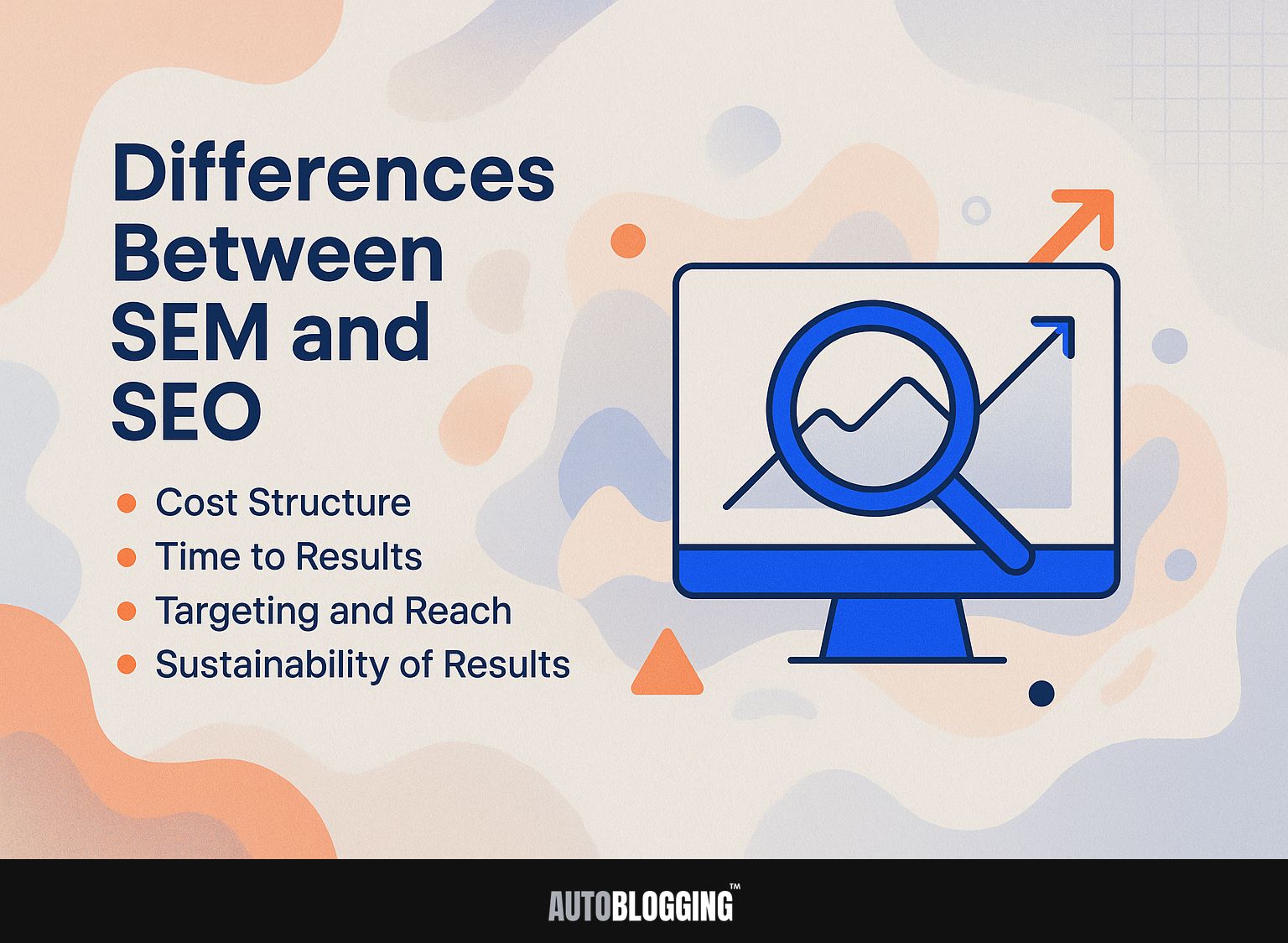
1. Cost Structure
While SEM typically involves ongoing costs like CPC, SEO requires investment in content creation and optimization strategies.
In SEM, businesses often face costs ranging from $1 to over $10 per click, depending on competitiveness. This means monthly budgets can easily reach thousands, particularly for high-demand keywords.
On the other hand, spending on SEO often includes buying tools for keyword research (such as Ahrefs or SEMrush for about $99 per month), creating content (costing between $50 and $500 per article), and improving technical SEO, which can add up to more than $1,000 each month.
Therefore, while SEM offers immediate visibility, SEO demands a longer-term commitment with potentially higher upfront costs.
2. Time to Results
SEM gives quick outcomes with paid advertisements, whereas SEO usually requires months to bring in organic visitors.
For example, with search engine marketing (SEM), a well-planned Google Ads campaign can quickly bring in clicks, driving traffic and possible sales right away.
On the other hand, good SEO methods, like using main keywords in content and getting backlinks, often take 3-6 months to achieve the best ranking in search engines.
Use Google Keyword Planner for SEM and Moz for SEO to monitor progress over time. Knowing these timeframes helps businesses decide how to use their resources better, whether they want fast returns or steady growth over time.
3. Targeting and Reach
SEM lets advertisers target people based on their age, location, and what they search for, unlike SEO, which usually targets a wider audience.
With SEM, marketers can select specific keywords that align with their target audience’s interests and behaviors. For instance, using Google Ads, businesses can bid on keywords relevant to their products, allowing them to appear at the top of search results when potential customers search for those terms.
Tools like Ahrefs or SEMrush can help identify high-converting keywords and segment audiences based on location, age, and interests.
In contrast, SEO involves creating content that organically attracts visitors, aiming for long-term visibility instead of the immediate results offered by SEM.
4. Sustainability of Results
While SEM results cease once campaigns stop, SEO efforts can provide ongoing organic visibility and traffic.
Investing in SEO creates a sustainable online presence. Unlike SEM, which relies heavily on ad spend, effective SEO tactics, such as keyword optimization, high-quality content creation, and building backlinks, yield long-term benefits.
For example, using tools like SEMrush for keyword research can help find important keywords to focus on. Regularly updating existing content improves rankings. This complete method increases regular visitors and builds credibility in your field, lowering the need for paid strategies as your natural audience grows over time.
Tools and Platforms for SEM
Selecting the best tools and platforms is essential for successful SEM campaigns, simplifying management and progress. Understanding the nuances of different advertising models can enhance these choices significantly. One of our hidden gems on PPC models provides insights into how effective ad strategies can complement your SEM efforts.
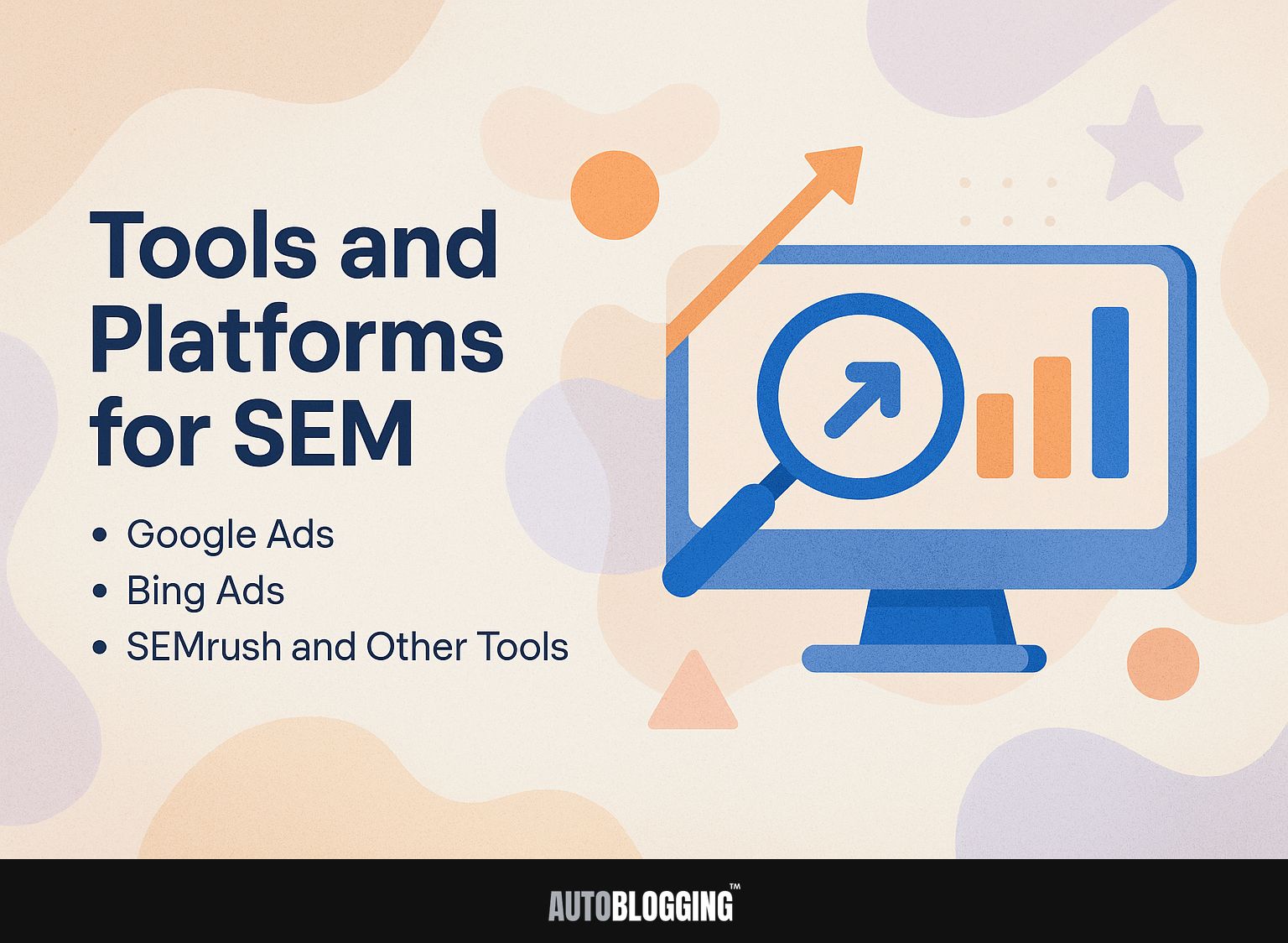
1. Google Ads
Google Ads is the top platform for search engine marketing, offering strong tools for managing campaigns and tracking how well they perform.
To get the most out of Google Ads, start by looking into where your ads can show: search ads appear at the top of search results, and display ads can be seen on many websites.
Use targeting capabilities like demographic, location, and keyword targeting to hone in on your ideal audience. Use performance data from Google Analytics or the Google Ads dashboard to check click-through rates and conversions.
As for pricing, it’s a pay-per-click model, meaning you only pay when someone clicks your ad, with costs varying widely depending on competition for keywords.
2. Bing Ads
Bing Ads lets advertisers connect with a different group of people, usually at lower prices than Google Ads, making it a good option.
Bing Ads works well for reaching groups like older professionals and technology enthusiasts, which can help increase your campaign’s return on investment. Its cost-per-click (CPC) is typically lower, allowing for more budget-friendly campaigns.
Integration with Microsoft services like LinkedIn offers unique marketing opportunities, enabling targeted ads based on user profiles.
For instance, combining Bing Ads with LinkedIn can help you reach decision-makers in specific industries more effectively. This plan increases visibility and improves interaction across platforms.
3. SEMrush and Other Tools
Tools like SEMrush give detailed information for SEM campaigns, showing how keywords work and analyzing competitors.
SEMrush is known for its strong keyword research features, allowing users to find popular keywords and evaluate competition. Its ad tracking feature allows marketers to evaluate the effectiveness of their PPC campaigns, providing essential data on clicks and impressions.
Another helpful feature is the site audit tool, which finds SEO problems that might affect ad performance, like broken links or slow loading times.
By bringing these features together, you understand your SEM strategy fully. This helps improve its overall success.
Common Mistakes in SEM
Avoiding common mistakes in SEM is important for getting the best return on investment and making sure campaigns run without issues.
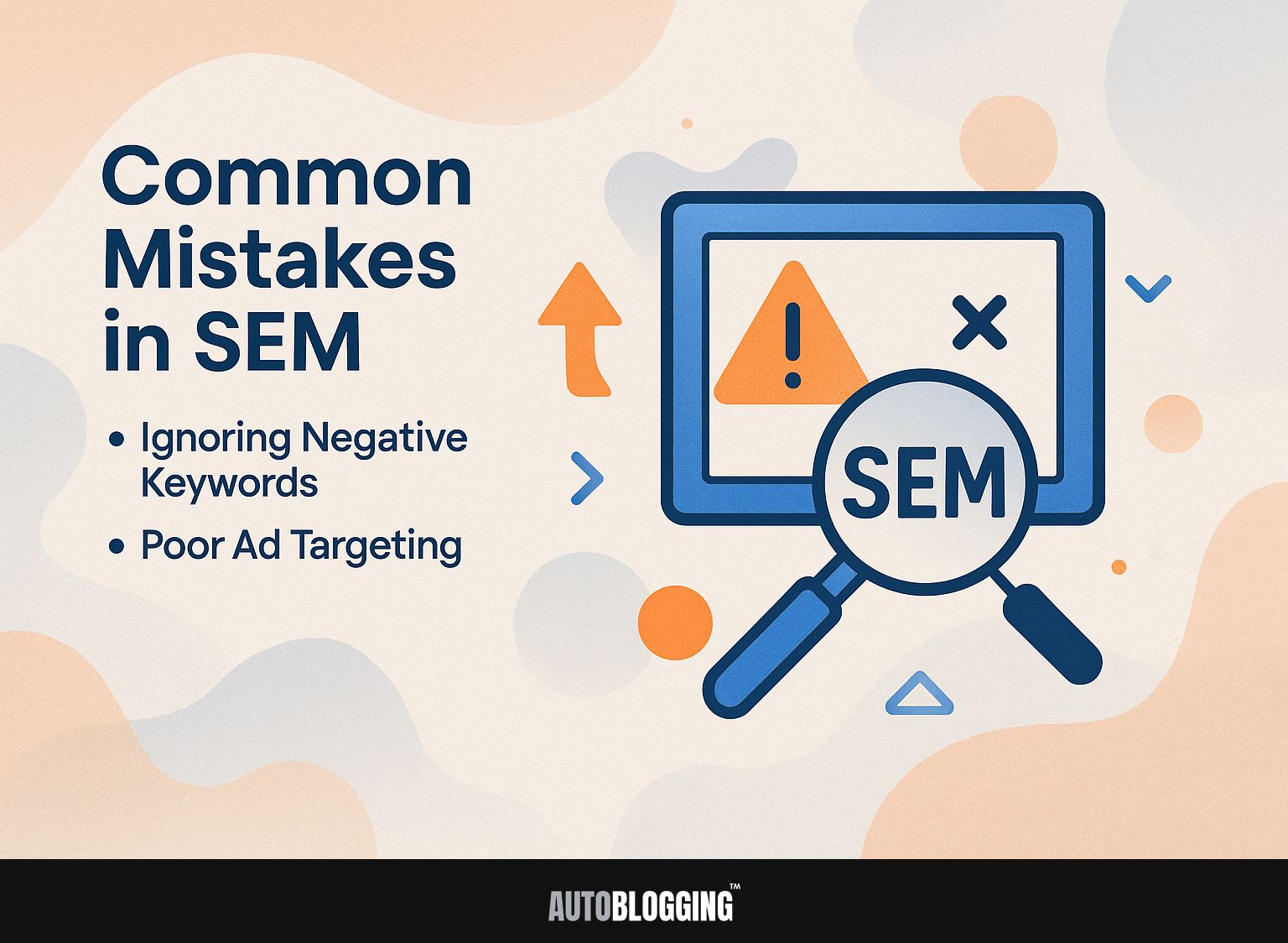
1. Ignoring Negative Keywords
Not using negative keywords can waste ad money and bring in the wrong visitors, which can greatly lower your ROI.
To implement negative keywords effectively, start by identifying terms that are unrelated to your business goals. For instance, if you sell premium surfboards, you might want to exclude ‘cheap’ or ‘free.’
Use tools like Google’s Keyword Planner to generate a list of negative keywords that align with your objectives. Avoid common mistakes such as overloading your campaigns with too many negative keywords, which can limit your audience reach.
Frequently check search term reports to improve your list. This helps it keep up with how consumers act and makes the most of your ad spending.
2. Poor Ad Targeting
Inadequate ad targeting can result in low engagement rates and poor conversion, wasting resources and time.
To improve how you target audiences in SEM campaigns, begin by looking at your current data to find the demographics that perform best.
Use tools like Google Analytics to segment your audience based on age, location, and interests. Next, use advanced features like remarketing lists and custom intents to target users who have visited your site before.
Try testing different ad designs and messages that fit particular groups. This approach makes your content more relevant, increases participation, and enhances your return on investment.
Frequently Asked Questions
1. What is SEM (Search Engine Marketing)?
SEM (Search Engine Marketing) is a form of digital marketing that focuses on promoting a website through paid advertising on search engines. This includes using techniques such as pay-per-click (PPC) advertising and search engine optimization (SEO) to increase a website’s visibility in search engine results pages.
2. What is the definition of SEM?
The definition of SEM (Search Engine Marketing) is the process of using paid advertising and search engine optimization techniques to increase a website’s visibility and traffic from search engines.
3. What are some strategies used in SEM?
Some common strategies used in SEM (Search Engine Marketing) include keyword research, PPC advertising, ad copy optimization, landing page optimization, and website analysis. These strategies are used to improve a website’s ranking and visibility in search engine results pages.
4. What are the differences between SEM and SEO?
The main difference between SEM (Search Engine Marketing) and SEO (Search Engine Optimization) is that SEM involves paying for advertising on search engines, while SEO focuses on improving a website’s ranking organically through optimization techniques. SEM can show quick results, but SEO requires time before you see the complete impact.
5. How does SEM benefit a website?
SEM (Search Engine Marketing) can benefit a website by increasing its visibility and traffic from search engines, which can lead to more conversions and sales. It also allows for more targeted advertising and the ability to track and measure the success of campaigns.
6. Is SEM necessary for a website’s success?
Although SEM can help a website get noticed, it is not essential for a website to succeed. Websites can still achieve high rankings and traffic through SEO and other marketing strategies. However, SEM can help with these efforts and deliver quicker results.
